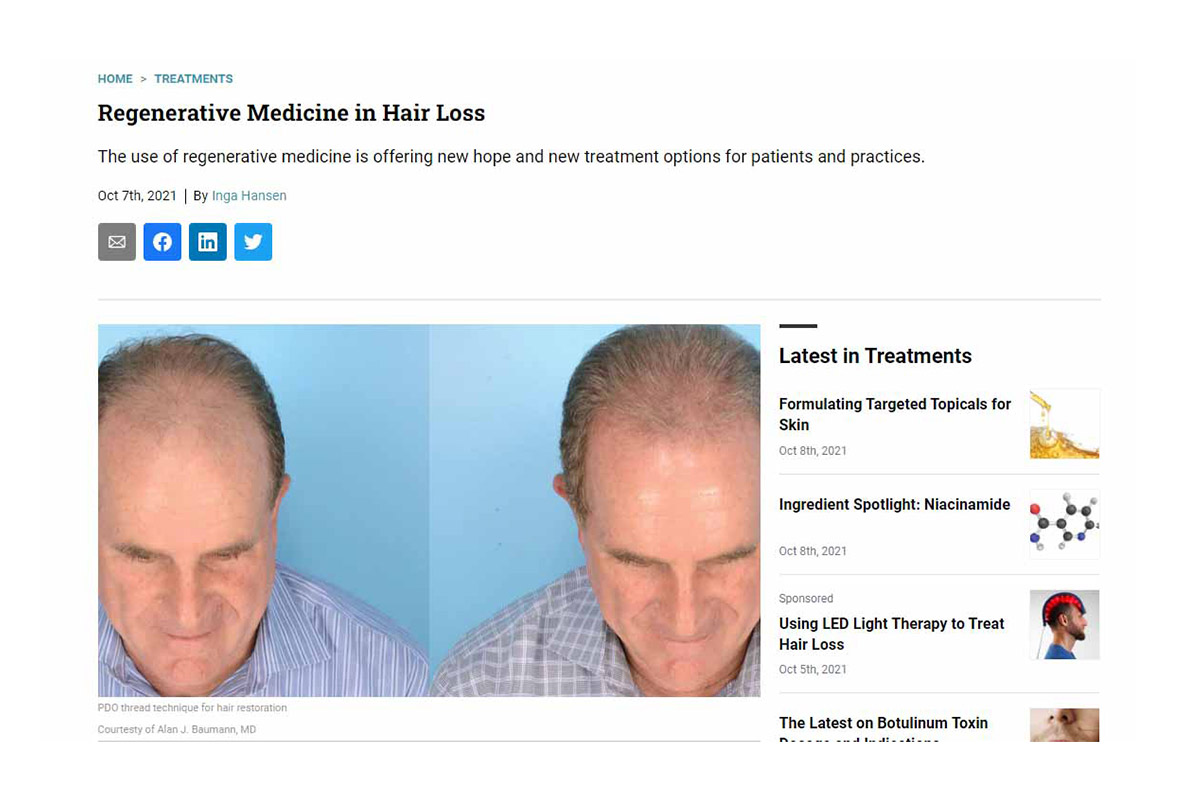

MedAesthetics USA Feature Article
Regenerative Medicine in Hair Loss
7th October 2021
The use of regenerative medicine is offering new hope and new treatment options for patients and practices.
Hair loss and thinning hair affect virtually all men and women as they age. For those affected in their earlier years, the change in physical appearance can be devastating. The main treatment options available have been daily oral or topical medications and hair transplant surgery for suitable candidates. But today, regenerative medicine—including the use of platelet-rich plasma, stem cells and exosomes—is bringing new minimally invasive options to the table.
One thing all these treatments have in common is that they are most effective in the early stages of hair loss. “To rejuvenate hair sufficiently, you need to catch the hairs before the point of no return,” says Dr. Farjo. “Therefore, these treatments are most effective for men and women who are younger and at an early stage of hair loss. This means that the hair loss started in the last few years.”
PRP
Dr. Farjo notes that equally important to dose is the depth of injection. “In the scalp, there is the skin and then the fat and then there is a bit of a space,” he says. “If you inject too deep, the PRP just swims underneath the tissue. You need to inject near the sebaceous glands to reach the cells that are actively trying to produce the hairs. This is about 1.8 mm from the surface of the scalp down to about 4 or 5 mm. That’s the crucial space, and it can vary from person to person.”
He uses very short needles and looks for a thickening of the skin. “If I can see a change in colour and texture of the skin, then I know I’m in the right area, rather than underneath the fat layer,” says Dr. Farjo.
When using PRP in combination with hair transplant surgery as regenerative medicine, Dr. Farjo injects prior to the surgery. “If I’m doing a hair transplant surgery and the patient still has some existing hair in the transplant area, PRP can boost that existing hair and help prevent collateral damage to that surrounding hair from the trauma of the surgery,” he says. “If they have scars on their head from previous surgery, injecting PRP before you do the procedure also can contribute to better healing and tissue repair and improve the blood supply, which, all together, leads to a much smoother recovery from the surgery. They may start seeing results much sooner as well.”
Exosomes
“Some people have found that exosomes can stimulate wound repair and hair growth, but the results are inconsistent and it is not a licensed product,” says Dr. Farjo. “Not only that, but the exosomes are coming from somebody else, and we don’t yet know the medium- and long-term implications of that.”
Hair Cloning
Dr. Farjo served as principal investigator for a clinical trial with Intercytex in the mid-2000s. Their aim was to isolate dermal papilla cells from hair at the back of the head. These are then multiplied and injected back into the same patient to grow new hair. Though the initial animal studies were highly successful, “in humans it just did not work,” he says. “The main problem was the culturing method at the time resulted in those cells losing their ability to make hair. They just became skin cells. We now realize that it was too ambitious to think, I’m going to grow a new hair in the middle of a bald spot”
He is now working with HairClone, which is focused on strengthening hairs that have miniaturized, rather than planting a seed in a bare area and making new hair grow. “We grow cells in a 3D structure as opposed to a 2D structure. They like that environment better and are more likely to retain their genetic nature. By focusing on strengthening existing hair, we introduce the new cells into an existing structure, so there is less for them to do.”
He has been studying this technique for the past four years and envisions the therapy as similar to PRP but with potentially much longer and more robust outcomes. “This would be for the patients who are looking for hair rejuvenation. The difference between PRP, LLLT and adipose-derived and stem cell treatment is that these treatments work by stimulating other cells, while this type of hair cloning works by introducing the cells that make hair back into the roots,” says Dr. Farjo.
Because the new cells are taken from the back of the head—an area not typically affected by DHT in male pattern baldness—they may be immune to the hormonal mechanism of hair loss. “The number of papilla cells in individuals with hair loss is decreasing,” he says. “And we know that the thickness of the hair shaft is related to the number of cells in the root. If you introduce more cells into this root, fattening it up basically, that will contribute to a thicker hair shaft. Because we took those cells from the back of the patient’s head, those cells are expected not to interact with the male hormone.”
Thinking about hair restoration? See how the experts at Farjo can help.